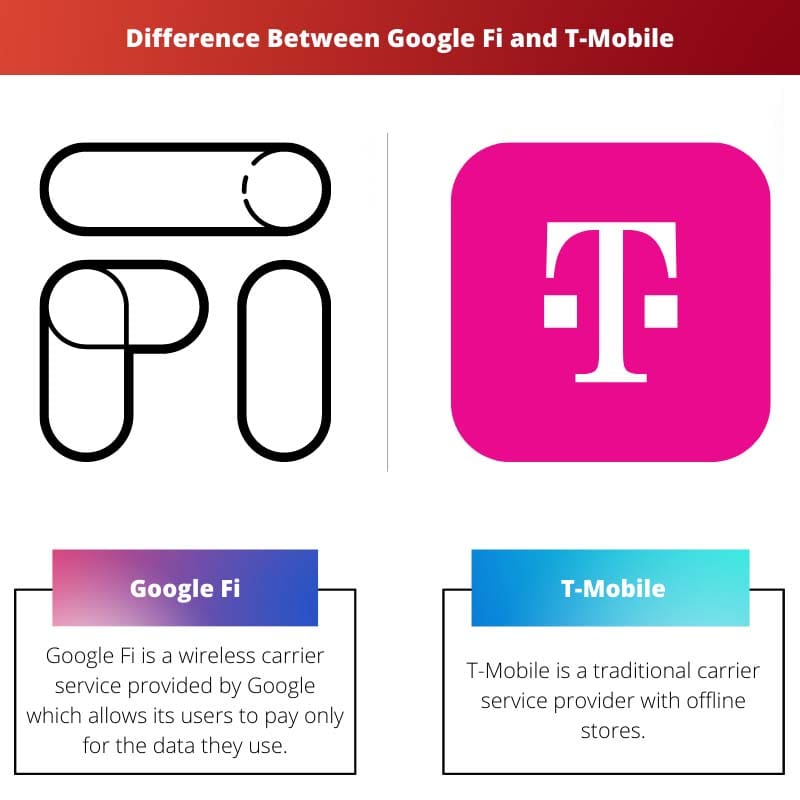With the growing technology, our dependency on it is also at an all-time high. Hence, Smartphones are a necessary modern-day need, and we need network services to use their full potential.
Key Takeaways
- Google Fi offers a pay-as-you-go plan with flexible data usage, while T-Mobile has traditional plans with specific data allowances.
- Google Fi automatically uses multiple networks and switches for better coverage, whereas T-Mobile relies on its network infrastructure.
- International roaming is included in Google Fi’s base plan, while T-Mobile offers it as an add-on or as part of specific plans.
Google Fi vs T-Mobile
The difference between Google Fi and T-Mobile is that Google Fi is an online-only mobile carrier service, whereas T-Mobile is available through dedicated offline retail stores. Google Fi is a mobile virtual network operator (MNVO) service, whereas T-Mobile has its own independent wireless network infrastructure.

Google Fi is a wireless carrier service provided by Google which allows its users to pay only for the data they use, which Google calls a pay-as-you-use plan.
T-Mobile is a traditional carrier service provider with offline stores. In mobile carriers, T-Mobile owns one of the largest network infrastructures. The services are provided with all phones there are.
Comparison Table
| Parameters of Comparison | Google Fi | T-Mobile |
|---|---|---|
| Offline Stores | Unavailable. | Dedicated offline stores are available. |
| Compatibility | Fully compatible only with Google’s native phones. | Fully compatible with all phones. |
| Network Coverage | No dedicated network towers. | An abundance of network towers. |
| Billing | Only autopay is available. | Various options include Autopay, online portals, and net banking. |
| Perks | Network switching, free VPN, free additional data-only sim, etc. | Subscriptions like Netflix, Weekly discounts, unlimited 3G hotspots, etc. |
What is Google Fi?
It is a mobile virtual network operator (MNVO) service. It doesn’t own independent wireless infrastructure and relies on conventional retailers, including T-Mobile and U.S Cellular, for network coverage.
Monthly plans are paid at every month’s billing cycle. The credit for unused data is transferred back to the user’s registered account at the end of the month, while overuse of services results in an extra charge.
Google Fi can switch between various networks depending on signal strength. It automatically connects to open Wifi hotspots if the data speeds are weaker than the Wifi and keep the data secure with encryption through the free VPN service. This transfer of network works for both internet usage and making phone calls.

What is T-Mobile?
It is the second-largest wireless carrier in the United States. In 2015, Consumer Reports considered T-Mobile as the best wireless carrier in the United States.
T-Mobile is known for its compatibility with all smartphones available in the market. With T-Mobile being a conventional provider, its reach is truly unmatched. T-Mobile offers its full potential to all smartphones in the market regardless of the brand.
One thing that makes T-Mobile stand out is the additional perks it provides to its users. Subscriptions of Netflix, Amazon Prime, Hotstar, unlimited 3G hotspots, T-Mobile Tuesdays that include weekly discounts, and many more. T-Mobile also has a wider range of payment methods as compared to other carrier services.

Main Differences Between Google Fi and T-Mobile
- Google Fi offers 5G access with only limited plans. On the other hand, T-Mobile offers 5G plans with all available plans.
- Google Fi’s highlighting point is the free VPN service for native devices, whereas T-Mobile offers no such service as default.

- https://media.ulii.org/files/government_gazette/files/ug-government-gazette-dated-2001-07-03-no-42.pdf
- http://sk.sagepub.com/cases/t-mobile-the-un-carrier-good-strategy-despite-ethical-concerns

The references provided at the end of the article add credibility to the information presented. This demonstrates a commitment to evidence-based reporting and further enhances the informative value of the content.
The comprehensive comparison table succinctly encapsulates the key differences between Google Fi and T-Mobile, enabling readers to evaluate their options with clarity. The addition of references further enhances the reliability of the information provided.
I completely agree, Joel. The table presents a clear breakdown of the essential parameters for comparison, facilitating an insightful assessment of Google Fi and T-Mobile’s offerings.
Indeed, the article’s in-depth analysis allows for an informed understanding of the features, functionality, and benefits of both network services. The thorough examination of Google Fi and T-Mobile provides readers with a comprehensive foundation for decision-making.
The article provides a comprehensive explanation of both Google Fi and T-Mobile, including thorough details about their key features, perks, and billing options. This allows readers to make informed decisions about their choice of network service.
The main differences outlined between Google Fi and T-Mobile are particularly useful, especially in clarifying the contrasting approaches to 5G access and VPN services offered by each provider.
The key takeaways of this article clearly help the reader to understand the differences between Google Fi and T-Mobile. The comparison table is particularly helpful, as it clearly lays out the parameters of comparison.
The extensive breakdown of Google Fi and T-Mobile’s offerings serves as a valuable resource for individuals seeking to switch or select a network service provider. The article effectively addresses the core distinctions, aiding readers in their decision-making process.
I appreciate the detailed information on Google Fi as a mobile virtual network operator and T-Mobile as a conventional carrier service provider. The article effectively highlights the differences and benefits of each, enabling readers to understand the distinction between the two.
The detailed comparison of Google Fi and T-Mobile presents a substantive analysis of their respective network coverage, compatibility, and billing methods. This level of depth allows readers to make well-informed decisions based on their specific needs and preferences.